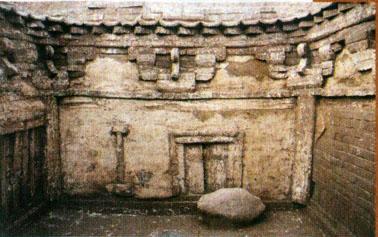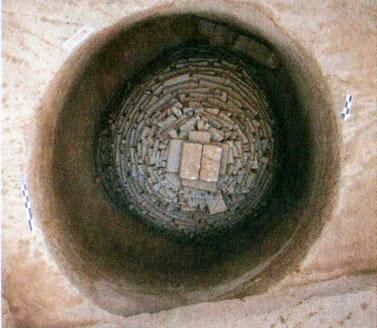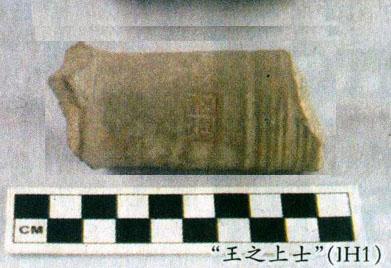Excavations and Achievements of the Wenqu Site and Tombs in Qi County of Shanxi Province
Chinese Archaeology
Source - http://www.kaogu.cn/en/detail.asp?ProductID=3192
WenQu Site is located in the neighborhood of Wenqu village, Guxian town, a place 3.5 kilometer southeast to Qi county of Shanxi Province. Excavations were constantly conducted from October, 2010 till January, 2011, in order to fit the infrastructure. Therefore, two sections, a total area of 1550 square meters, have been explored, including 15 pits, 1 trench, 30 tombs. Accompanying with these remains were numerous pottery, tubular and flat tiles, and etc. A number of significant literal material and inscribed symbols were discovered on some of the artifacts.

1. Remains from Warring States period to Qin-Han dynasties
As a result of the exploring, there was a large quantity of remains from the Late Warring States to Western Han Periods, mainly including constructing waste and tombs, and objects were distributed over 200 ha. Fifteen pits, one trench and six tombs were retrieved in excavations, dating to the Warring States period and Han dynasty. Other than the constructing waste, there were a few writing material that have been found, such as address “Qi”, words of official nature “Sergeant of the King” and “Shi”, “Wu”, inscribed symbols and etc.
Section I included objects from the early period, when a variety of kettle, bowl, pot and jar was most commonly seen. Otherwise, a smaller quantity of high-stemmed vessel, steaming and li tripod was found. Words or inscribed symbols, such as “Sergeant of the King”, “Jin”, “Wu”, were retrieved from this section. H1 was found in section I with rounded mouth, tubular body and flat base, 3 meter in diameter on mouth and 3.1 meter deep. Accompanying with the pit was a large quantity of objects, providing the evidence of a well likely. There have been totally more than thirty reconstructed wares, including kettle with protruding shoulder, basin with folded rim, elongated-necked and short-necked jar, artificial ring-footed bowl, rice steaming with elongated-neck, and high-stemmed vessel with shallow bowl. Otherwise, a small quantity of tubular and flat tiles was found.

Section II consisted of Western Han cultural deposits, including thirteen pits, one trench, and six tombs. The deposit of this section was deep, measuring two to three meter. Eight earth shaft tombs opened beneath the layer ②. There has been no clear evidence of a date of M8, but M1 from Yuan Period is in evidence. Other tombs have been identified to Western Han Period. They oriented to northeast with some exceptions, 170°, approximately. Buried within a coffin, the dead were arranged in extended supine position. Three of these tombs contained children buried in small pits, i.e., M4、M5 and M6. The dead was accompanied with a pottery jar placed beside his or her head, happened in both M4 and M6. The dead was covered by three flat tiles connected with one other in M5, where three “Wuzhu” coins were placed on the left chest. M5 was sealed with square bricks forwards and backwards. M2、M3 and M7 contained adults, accompanying with one to two ceramic jars inside niche or near the head. Other remains dated to the Western Han are comprised of thirteen pits and one trench, where numerous tiles, a smaller quantity of pottery, broken iron objects and animal bones were discovered. Typical literal material consisted of “Qi” found in H10:8, “Shi” in T3③:4 and etc..
Typical remains of the Warring States to Qin Periods found in Wenqu site are a variety of vessel types and shapes: kettle, basin and jar, the same to contemporary remains excavated in Qiaocun cemetery and Tianma — Qucun site. The evidence of constructing waste and the word “Qi” marked on the tiles may suggest that the location of “Qi” is consistent of the region near Wenqu village. This discovery could provide significant clue of specific location of Qi prior to Han Period as well as discussion of Qixi territory.

2. Tombs from Song-Yuan dynasties
A total of twenty-two tombs appear to have been from Song-Yuan Periods, including 21 distributed in section I, and one found in II.
Song-Yuan cemetery excavated in section I included 21 tombs clustering together. It is likely that this cemetery comprised of multiple tombs belonged to a family. Three tomb types have been identified, i.e. type A (12 in number), round and earth tombs with dromos and brick chambers;type B (5 in number), hammer- or 凸-shaped, earth pit with brick chamber; two tombs of type C, square, large earth pit ; one cave tomb(M18). Both type A and B were earth pit and brick chamber, about round in form, 2—3 meter in diameter, straight-walled, square-cornered, dome-structured. They had octagonal inner wall in their tomb chambers, and a coffin lay to the north on the floor paved with square bricks. Connected with the tomb chamber was a rectangular, shaft dromos with its floor sloping slightly going to the floor of the tomb chamber. A doorway has an arch-shaped top started from the tomb floor lying to the south of the tomb chamber.

M12 is consistent to the type C in shape, a square, earth shaft tomb. Its doorway measured 3.44 meter long, 3 meter wide. It had straight wall connected with a pit, 3.5 meter in depth. Second-tier platforms were found to the east, west and north. On the floor lay a rectangular coffin, out of which was a variety of fillings: lime, crushed stones and charcoals. Two dead persons were found, but the burial custom is not clear. Two brown-glazed porcelain jars were placed to the north. A total of sixty-one coins were found, Of which include “Chongning Zhongbao”, “Xining Yuanbao”, “Jiayou Tongbao”, “Xiangfu Yuanbao”, “Tiansheng Yuanbao”, “Tianxi Tongbao”, “Jingyou Yuanbao”, “Xianping Yuanbao”, “Huangsong Yuanbao”, “Zhihe Yuanbao”, and etc..
All the tombs from Song-Yuan Periods were multiple burials, since they contained two to eight dead persons. Secondary burial were mostly seen. Funerary inventory was normally placed around the head of the death, where the majority was a set of two porcelain jars. A Jar and bowl were also been seen. Another set of two bowls should be noticed. There are some exceptions that bronze coins were accompanied with the tombs.
M10 is typical among the tombs excavated for this time, since there was an epitaph found in the tomb. A date of the epitaph has shown “Zhiyuan Yuannian”. Accompanying inventory included a porcelain jar and such a bowl. A set of such kind has been commonly found in other contemporary tombs, providing a fresh evidence for the studies of burial custom of common people from Song-Yuan Periods. (Translator: Sang Li)